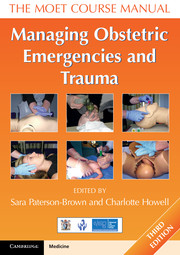Book contents
- Frontmatter
- Dedication
- Contents
- Working Group
- About the authors
- Acknowledgements
- Abbreviations
- Section 1 Introduction
- Section 2 Recognition
- 4 Recognising the seriously sick patient
- 5 Shock
- 6 Sepsis
- 7 Intravenous access and fluid replacement
- Section 3 Resuscitation
- Section 4 Trauma
- Section 5 Other medical and surgical emergencies
- Section 6 Obstetric emergencies
- Section 7 Triage and transfer
- Section 8 Human issues
- Index
6 - Sepsis
- Frontmatter
- Dedication
- Contents
- Working Group
- About the authors
- Acknowledgements
- Abbreviations
- Section 1 Introduction
- Section 2 Recognition
- 4 Recognising the seriously sick patient
- 5 Shock
- 6 Sepsis
- 7 Intravenous access and fluid replacement
- Section 3 Resuscitation
- Section 4 Trauma
- Section 5 Other medical and surgical emergencies
- Section 6 Obstetric emergencies
- Section 7 Triage and transfer
- Section 8 Human issues
- Index
Summary
Objectives
On successfully completing this topic, you will be able to:
discuss the pathophysiology of sepsis
identify the septic patient
commence supportive management
arrange appropriate investigations and referral.
Terminologies
Different terminologies have been used to describe the various manifestations of sepsis; a brief account of these will help in understanding the syndrome. Sepsis, severe sepsis and septic shock are terms used to identify the continuum of the clinical response to severe infection (Figure 6.1).
Introduction and incidence
Sepsis is one of the five major causes of maternal morbidity and mortality worldwide. It accounts for 10% of maternal mortality in the developed world. This figure is higher in the developing world as septic abortions are seen more frequently. Pregnant women tend to be young and healthy. Only 0–4% of pregnant women who develop bacteraemia develop septic shock and of these, 2–3% die.
There are specific opportunities to improve the management of the condition. Clinical trials involving new therapeutic interventions have demonstrated, for the first time in 20 years, improved survival in patients with severe sepsis and septic shock. Improvements in mortality can be made by:
• having a high index of suspicion to allow earlier identification/diagnosis of sepsis
• adopting agreed standards of care for timely investigation and treatment.
- Type
- Chapter
- Information
- Managing Obstetric Emergencies and TraumaThe MOET Course Manual, pp. 51 - 64Publisher: Cambridge University PressPrint publication year: 2014

